Numerical Simulation of Saltwater Intrusion in the Yangtze River Estuary Based on a Finite Volume Coastal Ocean Model
Abstract
:1. Introduction
2. Materials and Methods
2.1. Data
2.1.1. Remote Sensing Data
2.1.2. Forcing Data
2.1.3. Bathymetry and Topography Data

2.2. Model Configuration
2.3. Calculation of Saltwater Intrusion Distance
2.4. Power Spectrum Analysis
2.5. Model Validation
3. Results
3.1. Salinity Characteristics of the Yangtze River Estuary
3.2. Saltwater Intrusion in the Yangtze River Estuary
4. Discussion
4.1. Effect of Runoff on Saltwater Intrusion in the Yangtze River Estuary
4.2. Effect of Wind on Saltwater Intrusion in the Yangtze River Estuary
4.3. Effect of Tides on Saltwater Intrusion in the Yangtze River Estuary
4.4. Effect of Riverbank Morphology on Saltwater Intrusion in the Yangtze River Estuary
5. Conclusions
Author Contributions
Funding
Institutional Review Board Statement
Informed Consent Statement
Data Availability Statement
Acknowledgments
Conflicts of Interest
References
- Kuang, C.; Chen, W.; Gu, J.; Su, T.C.; Song, H.; Ma, Y.; Dong, Z. River discharge contribution to sea-level rise in the Yangtze River Estuary, China. Cont. Shelf Res. 2017, 134, 63–75. [Google Scholar] [CrossRef]
- Hao, Z.; Xu, M.; Zou, X.; Wang, C. The changing Changjiang River estuarine-coastal ocean continuum in the anthropocene. Catena 2024, 238, 107904. [Google Scholar] [CrossRef]
- Liu, L.; Sun, F.; Zhao, H.; Mi, H.; He, S.; Chen, Y.; Liu, Y.; Lan, H.; Zhang, M.; Wang, Z. Compositional changes of sedimentary microbes in the Yangtze River Estuary and their roles in the biochemical cycle. Sci. Total Environ. 2021, 760, 143383. [Google Scholar] [CrossRef] [PubMed]
- Xu, H.J.; Huang, Z.; Bai, Y.C.; Su, L.S.; Hong, Y.C.; Lu, T.T.; Wang, X. Numerical analysis of sediment deposition in Yangtze river estuary: Insight from conceptual estuary models. Appl. Ocean Res. 2020, 104, 102372. [Google Scholar] [CrossRef]
- Wang, T.; Geyer, W.R.; Maccready, P. Total exchange flow, entrainment and diffusive salt flux in estuaries. J. Phys. Oceanogr. 2017, 47, 1205–1220. [Google Scholar] [CrossRef]
- Wang, T.; Geyer, W.R.; Engel, P.; Jiang, W.; Feng, S. Mechanisms of tidal oscillatory salt transport in a partially stratified estuary. J. Phys. Oceanogr. 2015, 45, 2773–2789. [Google Scholar] [CrossRef]
- Wu, H.; Zhu, J.; Chen, B.; Chen, Y. Quantitative relationship of runoff and tide to saltwater spilling over from the North Branch in the Changjiang Estuary: A numerical study. Estuar. Coast. Shelf Sci. 2006, 69, 125–132. [Google Scholar] [CrossRef]
- Liu, T.H.; Wang, Y.K.; Wang, X.K.; Duan, H.F.; Yan, X.F. Morphological environment survey and hydrodynamic modeling of a large bifurcation-confluence complex in Yangtze River, China. Sci. Total Environ. 2020, 737, 139705. [Google Scholar] [CrossRef]
- Wang, X.G.; Hollanders, P.H.J. Effect of groundwater table control on water saving irrigation strategies in the Qingtongxia irrigation district. J. Hydrodyn. 2004, 16, 166–175. [Google Scholar]
- Dai, Z.; Mei, X.; Darby, S.E.; Lou, Y.; Li, W. Fluvial sediment transfer in the Changjiang (Yangtze) river-estuary depositional system. J. Hydrol. 2018, 566, 719–734. [Google Scholar] [CrossRef]
- Wan, Y.; Zhao, D. Observation of saltwater intrusion and ETM dynamics in a stably stratified estuary: The Yangtze Estuary, China. Environ. Monit. Assess. 2017, 189, 89. [Google Scholar] [CrossRef] [PubMed]
- Chen, W.; Chen, K.; Kuang, C.; Zhu, D.Z.; He, L.; Mao, X.; Liang, H.; Song, H. Influence of sea level rise on saline water intrusion in the Yangtze River Estuary, China. Appl. Ocean. Res. 2016, 54, 12–25. [Google Scholar] [CrossRef]
- Chen, W.; Mao, C.; He, L.; Jiang, M. Sea-level rise impacts on the saline water intrusion and stratification of the Yangtze Estuary. J. Coast. Res. 2020, 95, 1395–1400. [Google Scholar] [CrossRef]
- Zhu, J.; Wu, H.; Li, L.; Qiu, C. Saltwater intrusion in the Changjiang Estuary. In Coastal Environment, Disaster, and Infrastructure—A Case Study of China’s Coastline; IntechOpen: Rijeka, Croatia, 2018; pp. 49–73. [Google Scholar]
- Xu, Z.; Ma, J.; Wang, H.; Hu, Y.; Yang, G.; Deng, W. River discharge and saltwater intrusion level study of Yangtze River Estuary, China. Water 2018, 10, 683. [Google Scholar] [CrossRef]
- Qiu, C.; Zhu, J.; Gu, Y. Impact of seasonal tide variation on saltwater intrusion in the Changjiang River estuary. Chin. J. Oceanol. Limnol. 2012, 30, 342–351. [Google Scholar] [CrossRef]
- Li, L.; Zhu, J.; Chant, R.J.; Wang, C.; Pareja-Roman, L.F. Effect of dikes on saltwater intrusion under various wind conditions in the Changjiang Estuary. J. Geophys. Res. Ocean. 2020, 125, e2019JC015685. [Google Scholar] [CrossRef]
- Huang, H.; Wang, Y.; Wang, S.; Lan, Y.; Huang, X. Saltwater Intrusion in the Changjiang River Estuary in Response to the East Route of the South-to-North Water Transfer Project in the New Period after 2003. Sustainability 2024, 16, 683. [Google Scholar] [CrossRef]
- Chen, C.; Huang, H.; Beardsley, R.C.; Xu, Q.; Limeburner, R.; Cowles, G.W.; Sun, Y.; Qi, J.; Lin, H. Tidal dynamics in the Gulf of Maine and New England Shelf: An application of FVCOM. J. Geophys. Res. Ocean. 2011, 116, C12010. [Google Scholar] [CrossRef]
- Ge, J.; Ding, P.; Chen, C.; Hu, S.; Fu, G.; Wu, L. An integrated East China Sea–Changjiang Estuary model system with aim at resolving multi-scale regional–shelf–estuarine dynamics. Ocean Dyn. 2013, 63, 881–900. [Google Scholar] [CrossRef]
- Ge, J.; Lu, J.; Zhang, J.; Chen, C.; Liu, A.; Ding, P. Saltwater Intrusion-Induced Flow Reversal in the Changjiang Estuary. J. Geophys. Res. Ocean. 2022, 127, e2021JC018270. [Google Scholar] [CrossRef]
- Zhang, Z.; Chen, C.; Song, Z.; Zhang, D.; Hu, D.; Guo, F. A FVCOM study of the potential coastal flooding in apponagansett bay and clarks cove, Dartmouth Town (MA). Nat. Hazards 2020, 103, 2787–2809. [Google Scholar] [CrossRef]
- Xue, P.; Chen, C.; Ding, P.; Beardsley, R.C.; Lin, H.; Ge, J.; Kong, Y. Saltwater intrusion into the Changjiang River: A model-guided mechanism study. J. Geophys. Res. Ocean. 2009, 114, C02006. [Google Scholar] [CrossRef]
- Yang, Z.; Khangaonkar, T. Modeling of salt intrusion, intertidal mixing, and circulation in a braided estuary. J. Coast. Res. 2008, 10052, 171–180. [Google Scholar] [CrossRef]
- Wang, J.H.; Zhang, D.B.; Zhang, W.S.; Zhang, J.S. Impacts of different dynamic factors on the saltwater intrusion in the northern branch of the yangtze estuary. China Ocean Eng. 2019, 33, 673–684. [Google Scholar] [CrossRef]
- Cheng, X.J.; Zhan, W.; Guo, Z.R.; Yuan, L.R. A modeling study on saltwater intrusion to western four watercourses in the Pearl River estuary. China Ocean Eng. 2012, 26, 575–590. [Google Scholar] [CrossRef]
- Shen, Y.; Jia, H.; Li, C.; Tang, J. Numerical simulation of saltwater intrusion and storm surge effects of reclamation in Pearl River Estuary, China. Appl. Ocean Res. 2018, 79, 101–112. [Google Scholar] [CrossRef]
- Xu, Z.; Ma, J.; Hu, Y. Saltwater intrusion function and preliminary application in the Yangtze River Estuary, China. Int. J. Environ. Res. Public Health 2019, 16, 118. [Google Scholar] [CrossRef]
- Chen, C.; Liu, H.; Beardsley, R.C. An Unstructured Grid, Finite-Volume, Three-Dimensional, Primitive Equations Ocean Model: Application to Coastal Ocean and Estuaries. J. Atmos. Ocean. Technol. 2003, 20, 159–186. [Google Scholar] [CrossRef]
- Chen, C.; Huang, H.; Beardsley, R.C.; Liu, H.; Xu, Q.; Cowles, G. A finite volume numerical approach for coastal ocean circulation studies: Comparisons with finite difference models. J. Geophys. Res. Ocean. 2007, 112, 83–87. [Google Scholar] [CrossRef]
- Wu, L.; Chen, C.; Guo, P.; Shi, M.; Qi, J.; Ge, J. A FVCOM-based unstructured grid wave, current, sediment transport model, I. Model description and validation. J. Ocean. Univ. China 2011, 10, 1–8. [Google Scholar] [CrossRef]
- Yu, K.; Liu, H.; Chen, Y.; Dong, C.; Dong, J.; Yan, Y.; Wang, D. Impacts of the mid-latitude westerlies anomaly on the decadal sea level variability east of China. Clim. Dyn. 2019, 53, 5985–5998. [Google Scholar] [CrossRef]
- Kalnay, E.; Kanamitsu, M.; Kistler, R.; Collins, W.; Deaven, D.; Gandin, L.; Iredell, M.; Saha, S.; White, G.; Woollen, J.; et al. The NCEP/NCAR 40-year reanalysis project. Bull. Am. Meteorol. Soc. 1996, 77, 437–471. [Google Scholar] [CrossRef]
- Lan, J.; Wang, Y.; Wang, G. A subsurface intensity index of the cold eddy in the East China Sea. Chin. J. Oceanol. Limnol. 2010, 28, 1275–1280. [Google Scholar] [CrossRef]
- Duan, Y.; Liu, H.; Yu, W.; Hou, Y. The mean properties and variations of the Southern Hemisphere subpolar gyres estimated by Simple Ocean Data Assimilation (SODA) products. Acta Oceanol. Sin. 2016, 35, 8–13. [Google Scholar] [CrossRef]
- Liu, H.; Zhang, Q.; Pang, C.; Duan, Y.; Xu, J. The seasonal variation of the north Pacific meridional overturning circulation heat transport. J. Oceanol. Limnol. 2019, 037, 423–433. [Google Scholar] [CrossRef]
- Qi, P.; Guo, Y.X. Interpretation of Subsurface Salinity EOFs on Southern ECS Shelf Using SODA Reanalysis: Large-Scale Patterns and Seasonal to Interannual Variations. J. Geophys. Res. Ocean. 2022, 127, e2020JC017038. [Google Scholar] [CrossRef]
- Li, L.; Zhu, J.; Wu, H.; Wang, B. A numerical study on water diversion ratio of the Changjiang (Yangtze) estuary in dry season. Chin. J. Oceanol. Limnol. 2010, 28, 700–712. [Google Scholar] [CrossRef]
- Shi, H.; Gao, C.; Dong, C.; Xia, C.; Xu, G. Variation of river islands around a large city along the Yangtze River from satellite remote sensing images. Sensors 2017, 17, 2213. [Google Scholar] [CrossRef]
- Lyu, H.; Zhu, J. Impact of the bottom drag coefficient on saltwater intrusion in the extremely shallow estuary. J. Hydrol. 2018, 557, 838–850. [Google Scholar] [CrossRef]
- Shi, H.; Cao, Y.; Dong, C.; Xia, C.; Li, C. The Spatio-Temporal Evolution of River Island Based on Landsat Satellite Imagery, Hydrodynamic Numerical Simulation and Observed Data. Remote Sens. 2018, 10, 2046. [Google Scholar] [CrossRef]
- Wu, H.; Zhu, J.; Choi, B.H. Links between saltwater intrusion and subtidal circulation in the Changjiang Estuary: A model-guided study. Cont. Shelf Res. 2010, 30, 1891–1905. [Google Scholar] [CrossRef]
- Tian, R. Factors controlling saltwater intrusion across multi-time scales in estuaries, Chester River, Chesapeake Bay. Estuar. Coast. Shelf Sci. 2019, 223, 61–73. [Google Scholar] [CrossRef]
- Tao, Z.; Chu, A.; Chen, Y.; Lu, S.; Wang, B. Wind effect on the saltwater intrusion in the Yangtze estuary. J. Coast. Res. 2020, 105, 42–46. [Google Scholar] [CrossRef]
- Li, Z.; Zhu, J. Numerical simulation of the North Branch regime change impact on saltwater intrusion in the Yangtze River Estuary from 2007 to 2016. J. East China Norm. Univ. (Nat. Sci.) 2022, 2022, 109. [Google Scholar]
- Werner, A.D.; Simmons, C.T. Impact of sea-level rise on sea water intrusion in coastal aquifers. Groundwater 2009, 47, 197–204. [Google Scholar] [CrossRef]
- Qiu, C.; Zhu, J. Assessing the influence of sea level rise on salt transport processes and estuarine circulation in the Changjiang River estuary. J. Coast. Res. 2015, 31, 661–670. [Google Scholar] [CrossRef]
- Qiu, C.; Zhu, J.-R. Influence of seasonal runoff regulation by the Three Gorges Reservoir on saltwater intrusion in the Changjiang River Estuary. Cont. Shelf Res. 2013, 71, 16–26. [Google Scholar] [CrossRef]
- Zhou, Z.; Ge, J.; Van Maren, D.S.; Kuai, Y.; Ding, P.; Wang, Z.B. Groyne-Induced Effects on Channel-Shoal Exchange and Saltwater Intrusion in Estuarine Environments. J. Hydraul. Eng. 2024, 150, 04023056. [Google Scholar] [CrossRef]
- Chang, Y.; Li, X.; Wang, Y.P.; Klingbeil, K.; Li, W.; Zhang, F.; Burchard, H. Salinity mixing in a tidal multi-branched estuary with huge and variable runoff. J. Hydrol. 2024, 634, 131094. [Google Scholar] [CrossRef]

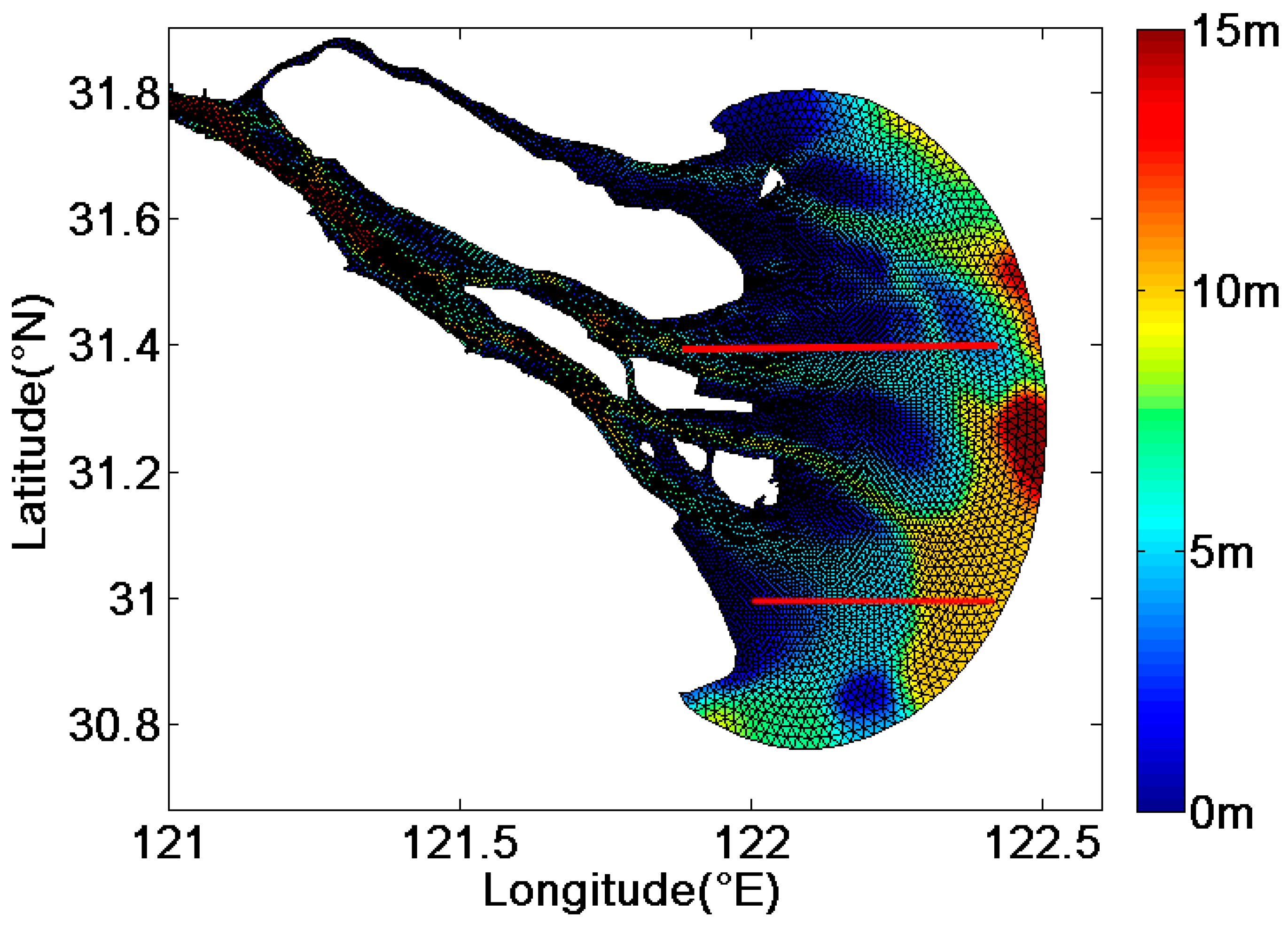
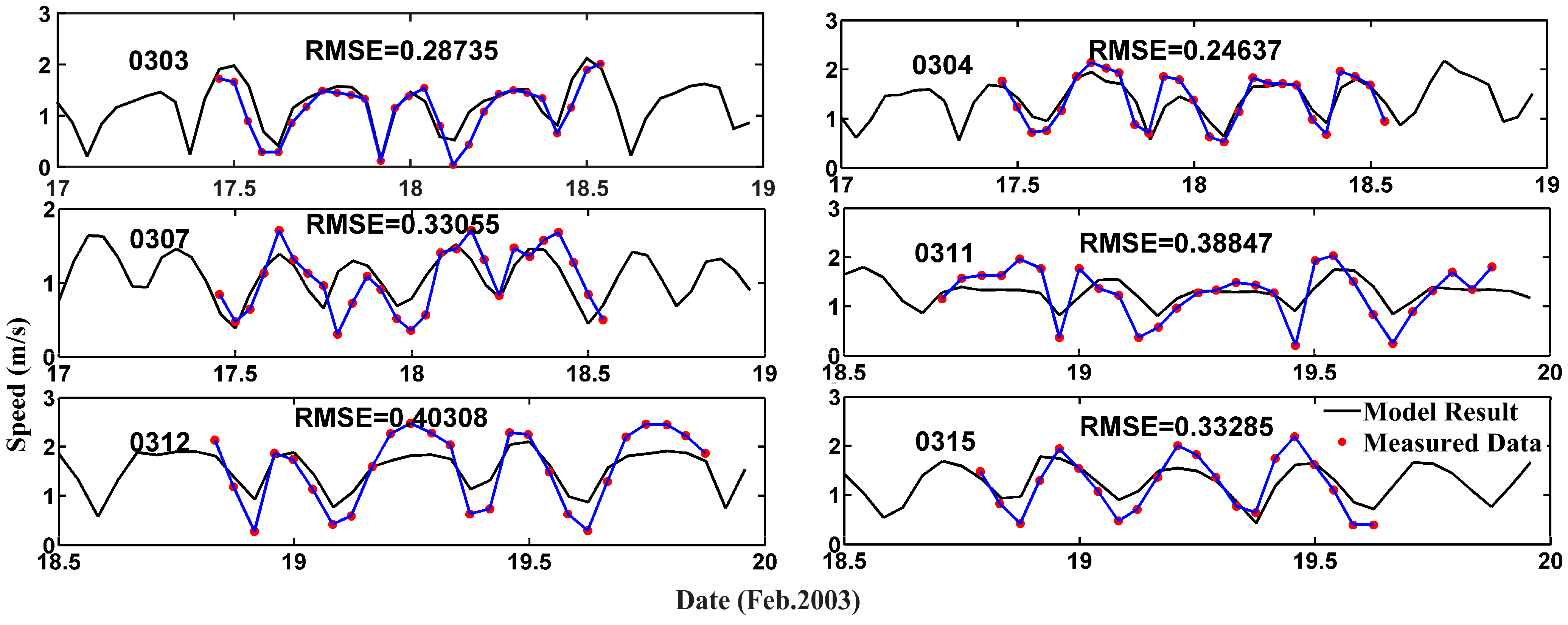
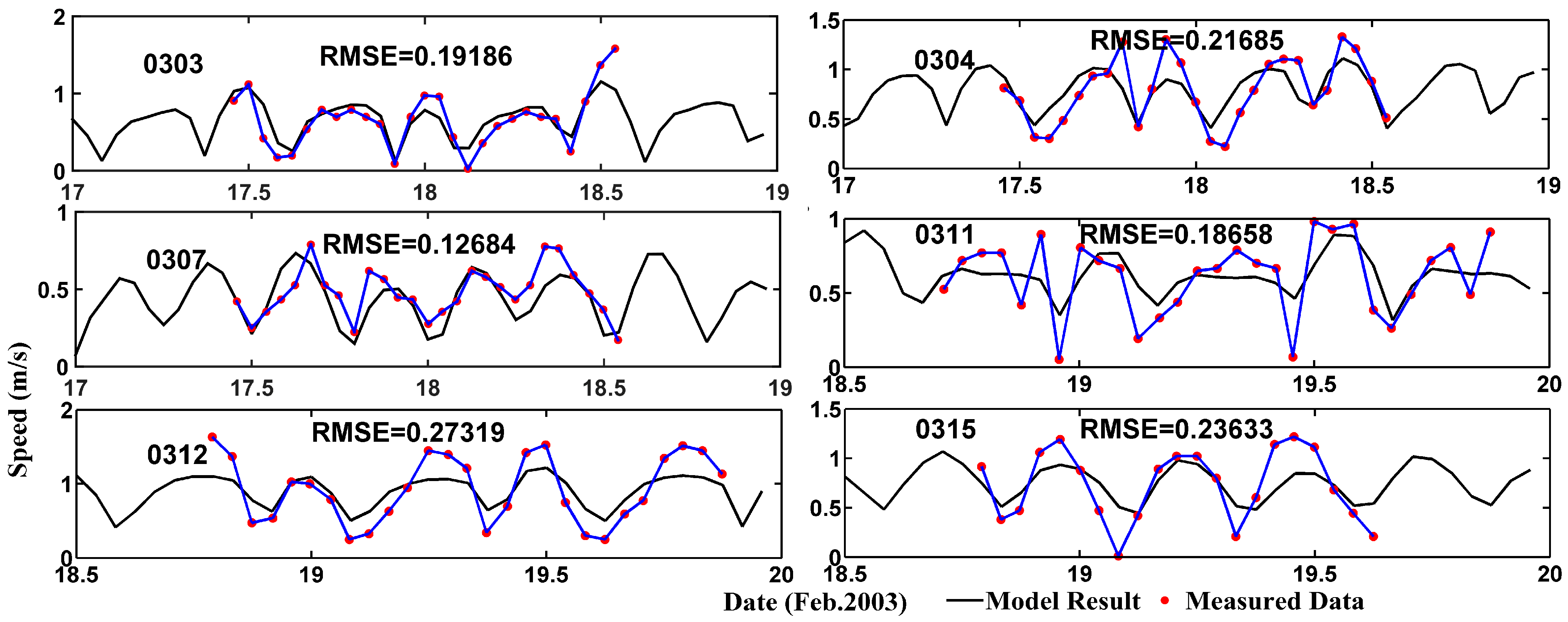
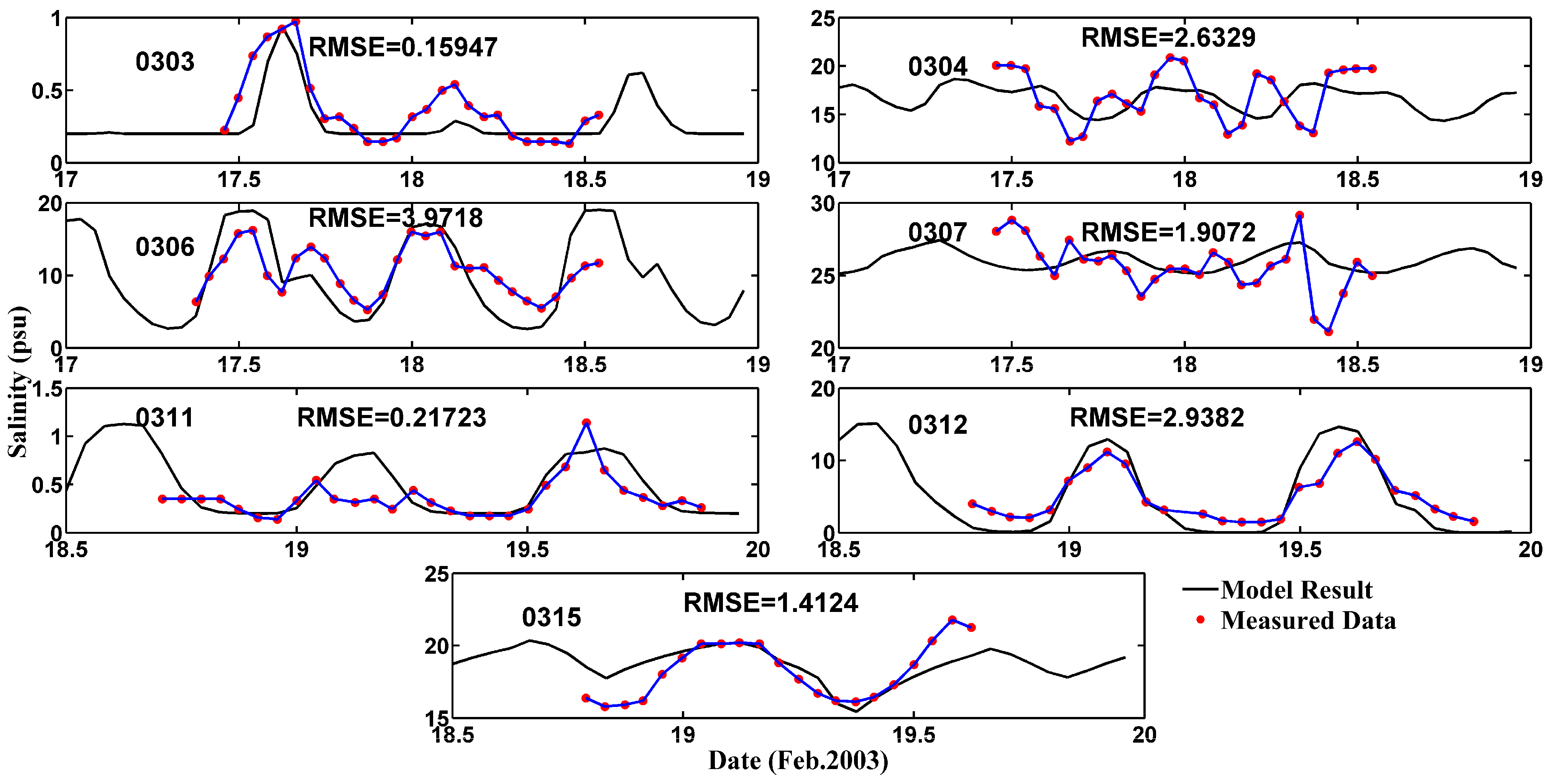
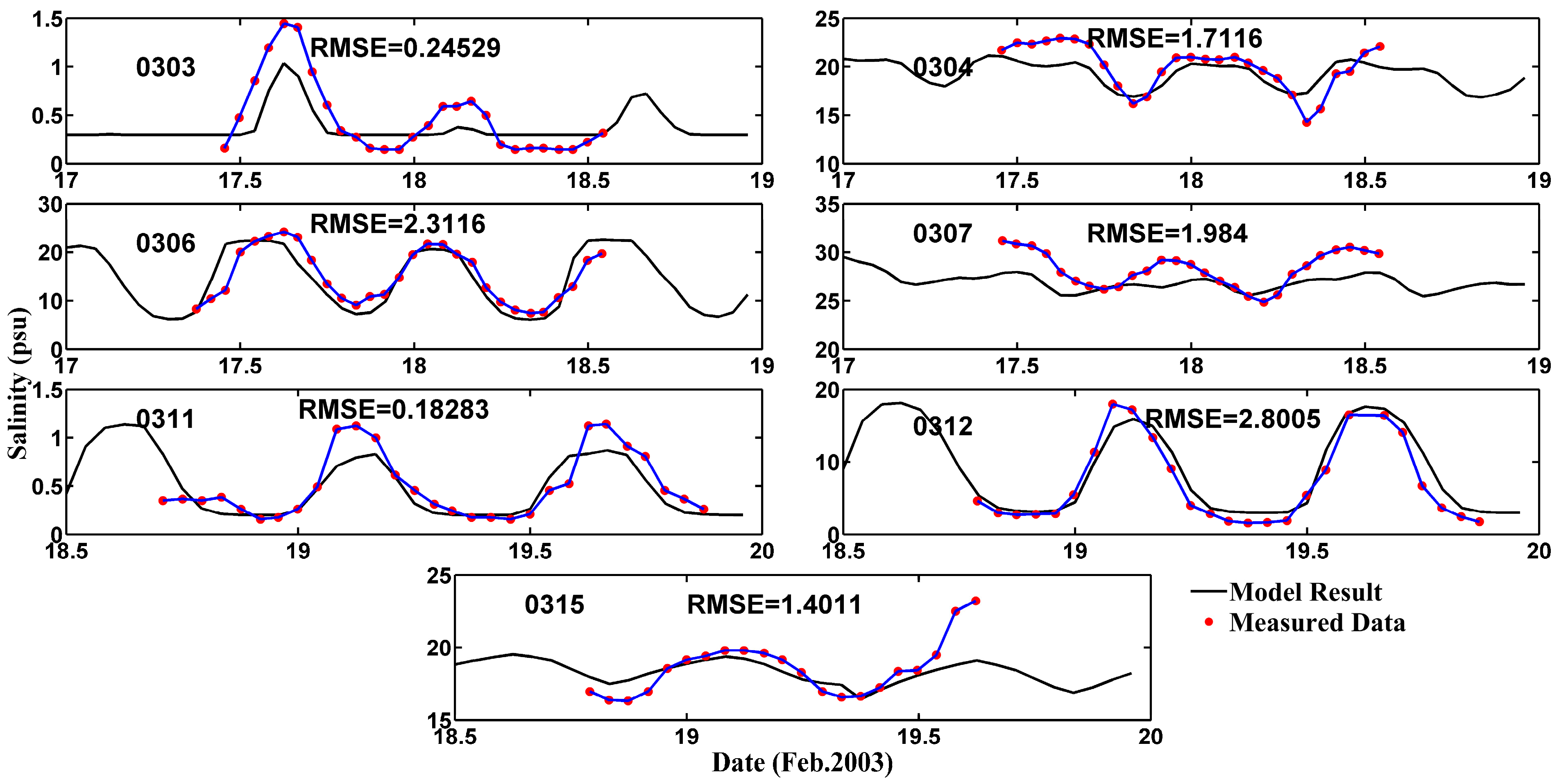
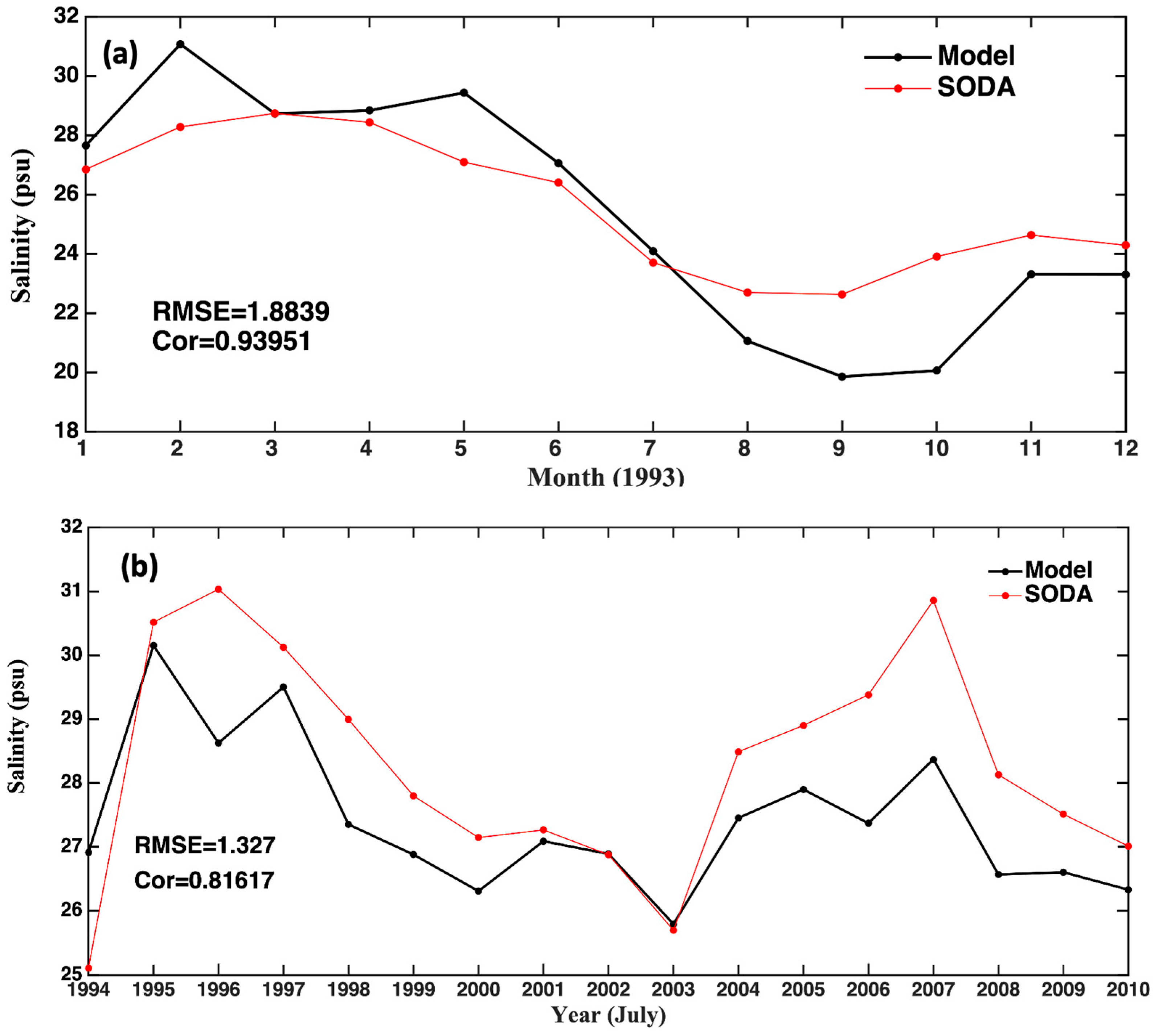
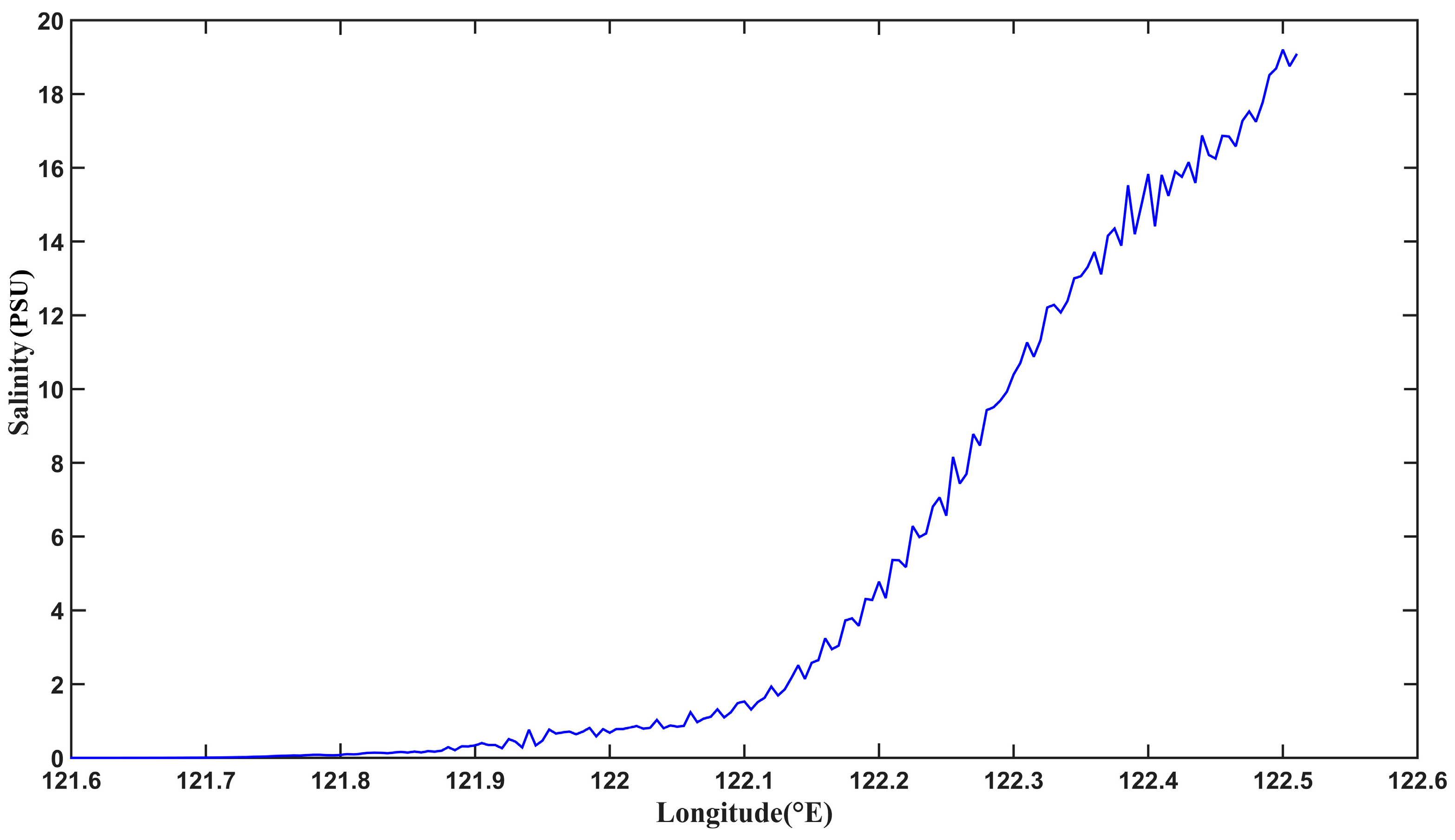
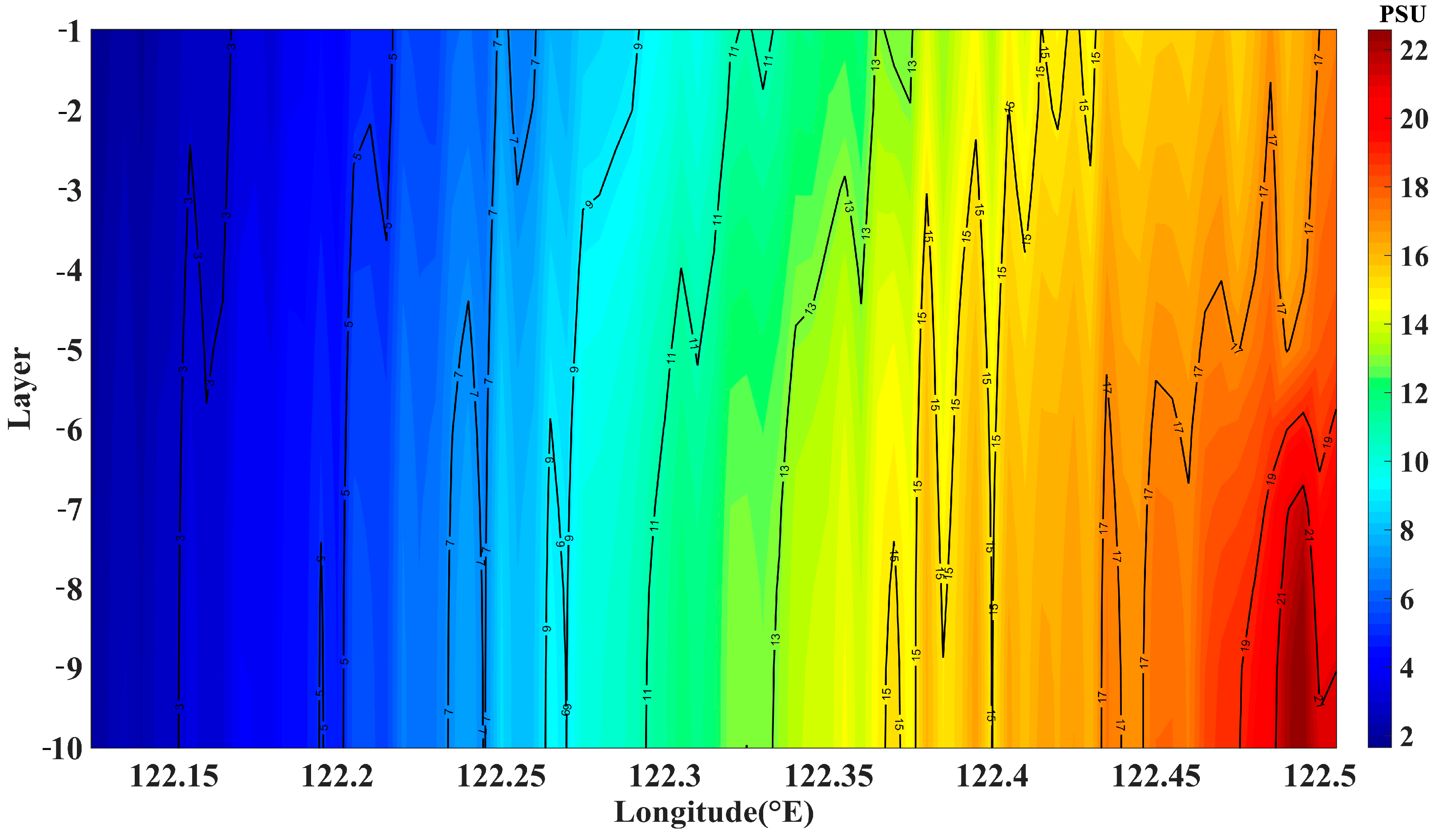
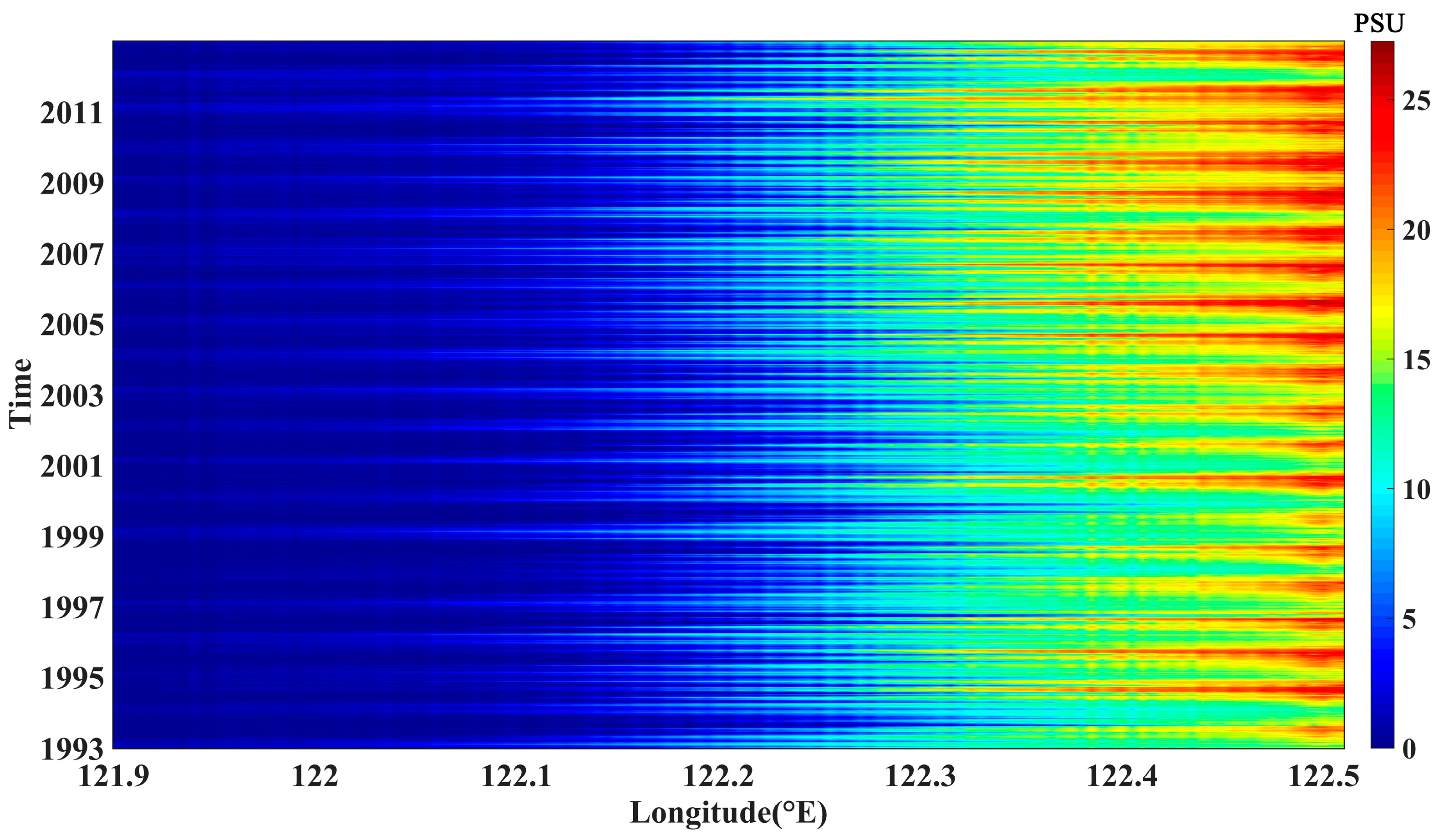

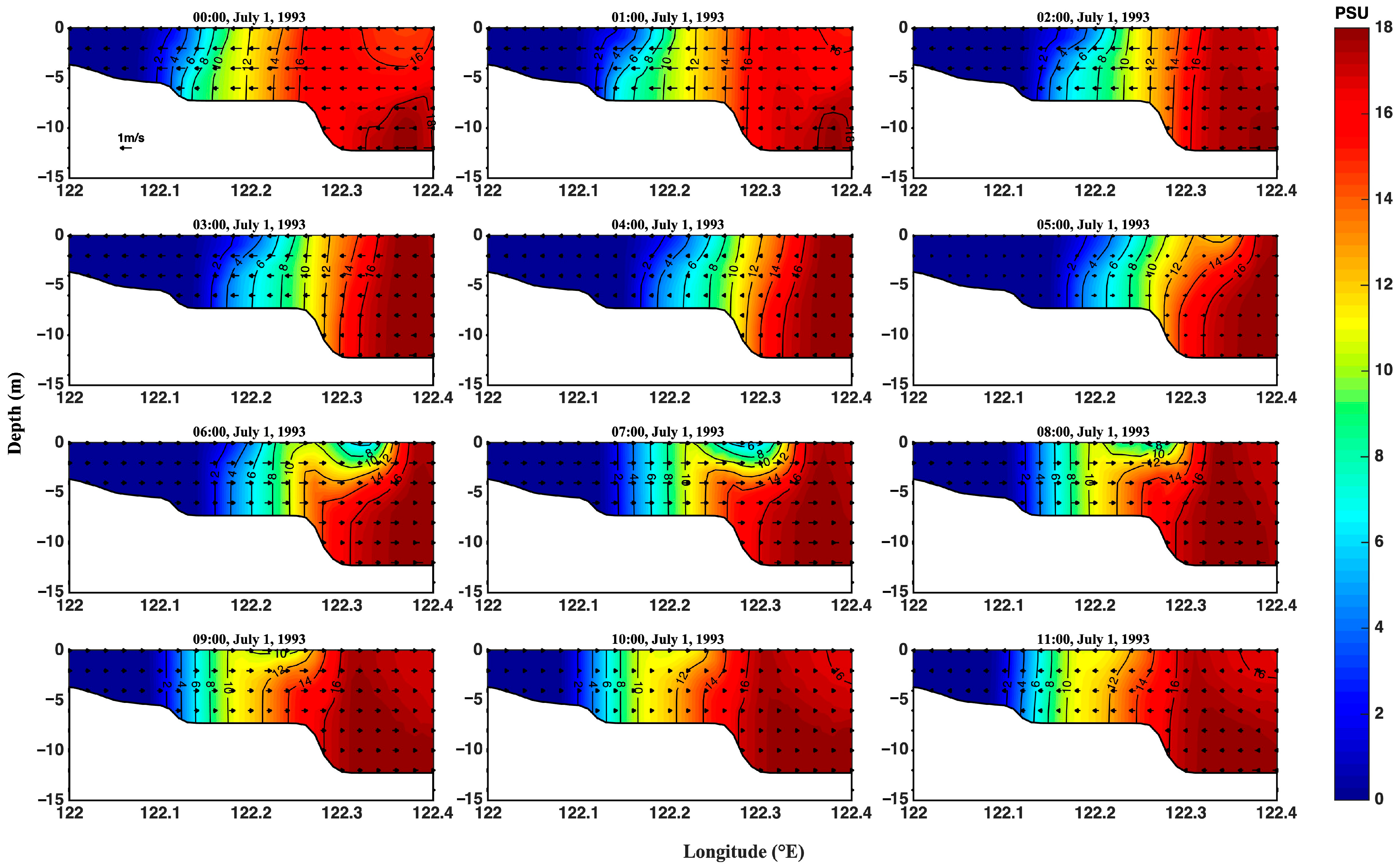
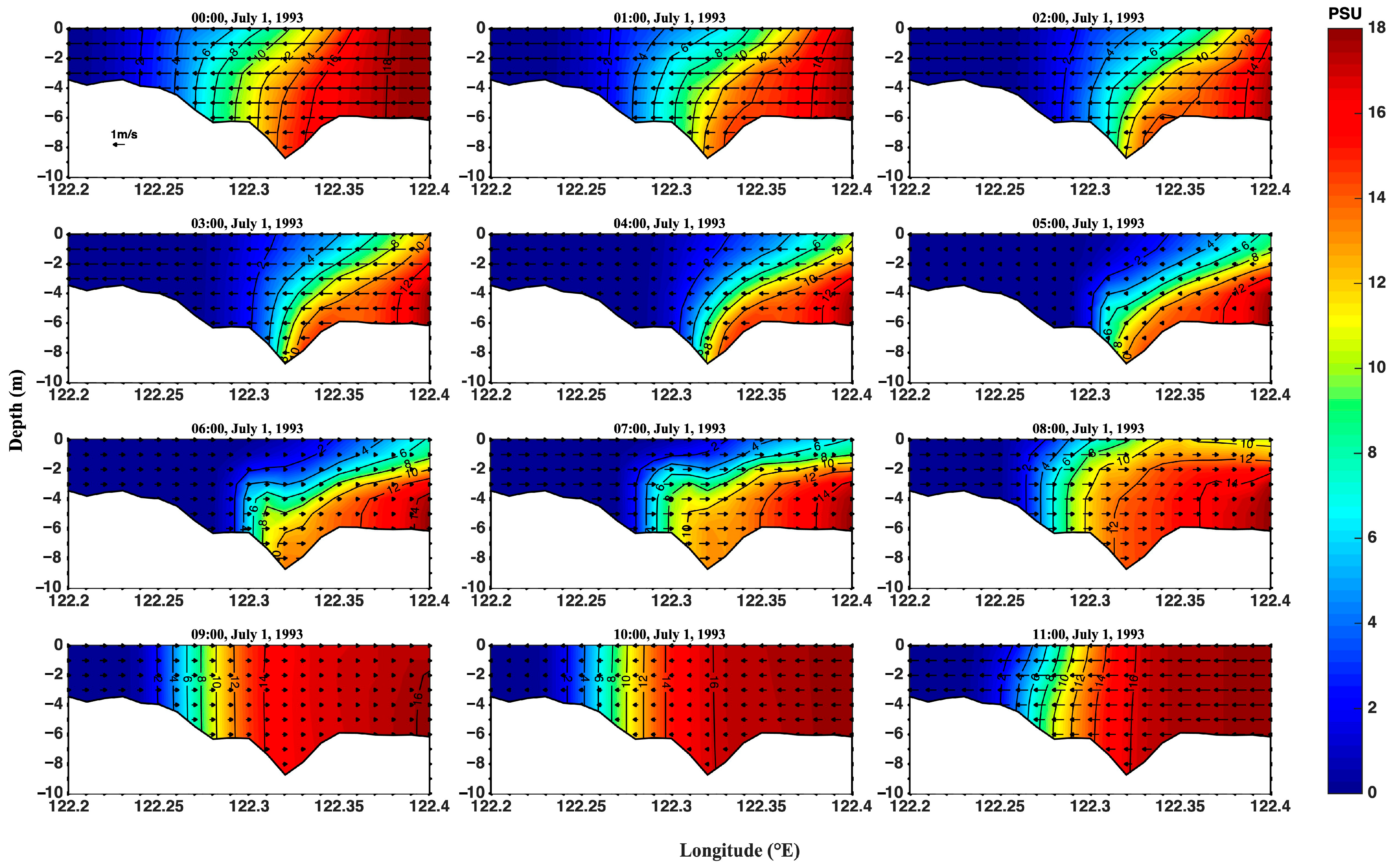


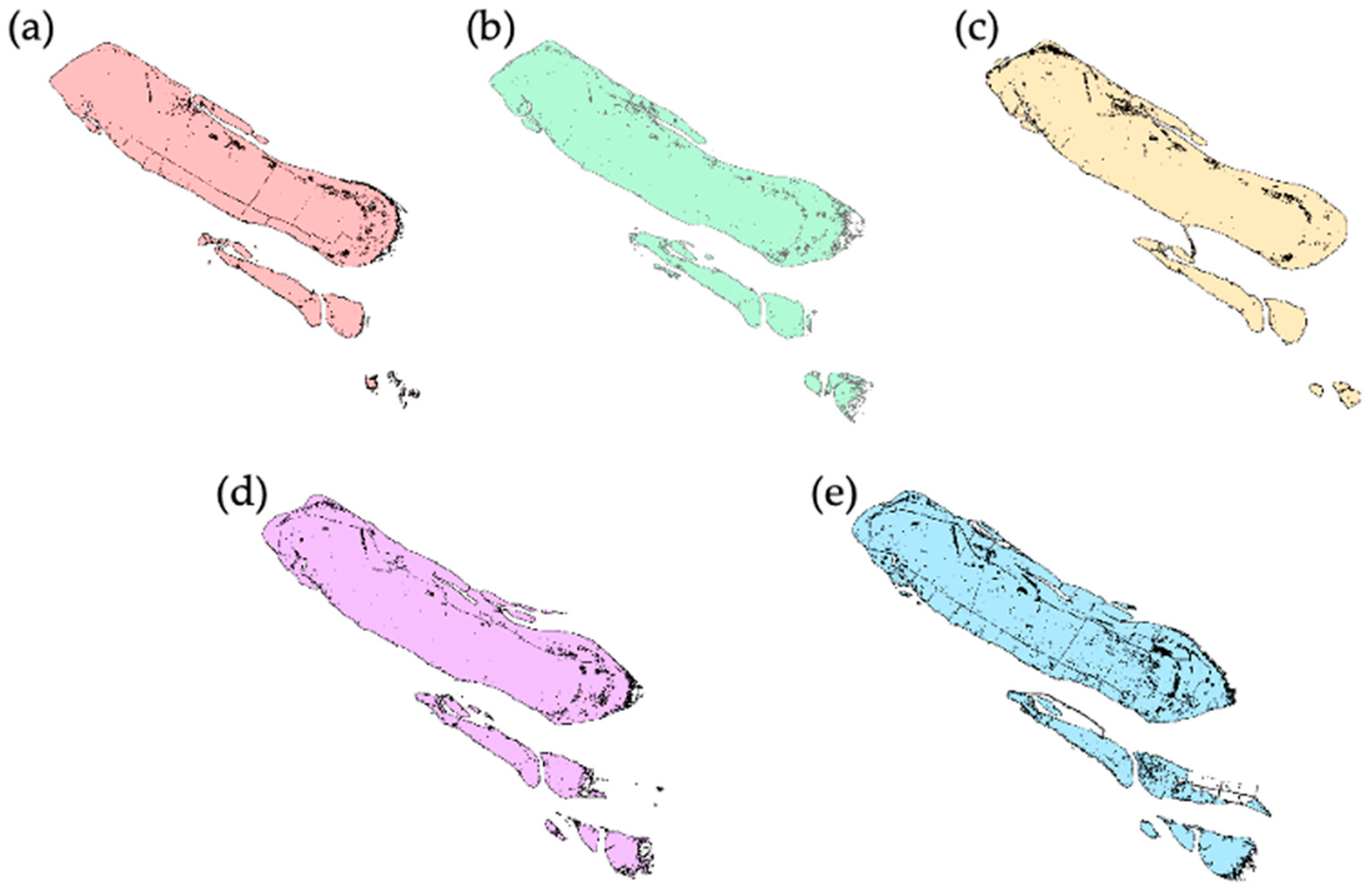
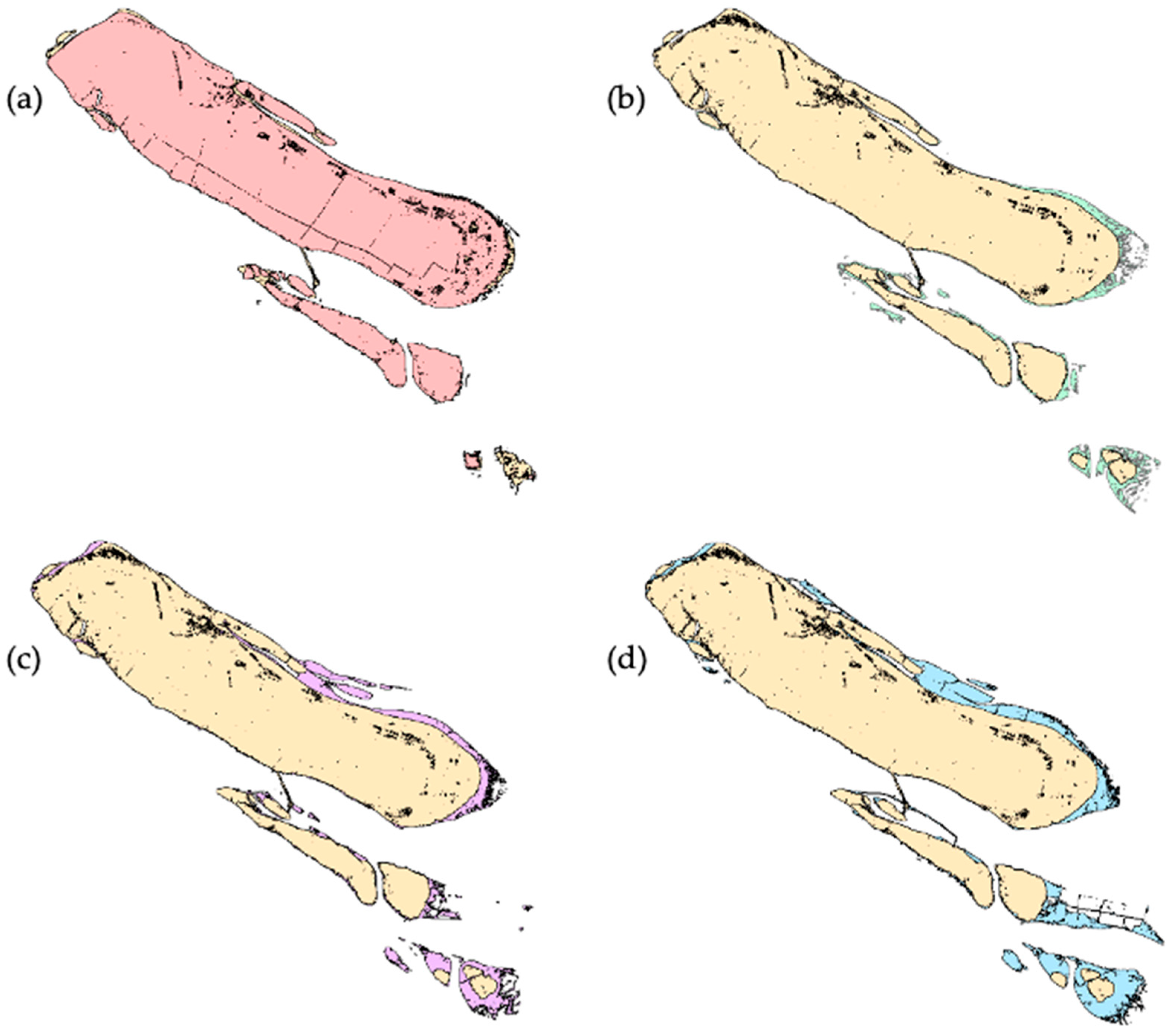
| Date | Satellite | Sensor | Resolution (m) |
|---|---|---|---|
| 31 March 1993 | Landsat-5 | TM | 30 |
| 11 April 1997 | Landsat-5 | TM | 30 |
| 11 January 2002 | Landsat-7 | ETM | 30 |
| 7 April 2007 | Landsat-5 | TM | 30 |
| 6 November 2012 | Landsat-7 | UTM | 30 |
Disclaimer/Publisher’s Note: The statements, opinions and data contained in all publications are solely those of the individual author(s) and contributor(s) and not of MDPI and/or the editor(s). MDPI and/or the editor(s) disclaim responsibility for any injury to people or property resulting from any ideas, methods, instructions or products referred to in the content. |
© 2024 by the authors. Licensee MDPI, Basel, Switzerland. This article is an open access article distributed under the terms and conditions of the Creative Commons Attribution (CC BY) license (https://creativecommons.org/licenses/by/4.0/).
Share and Cite
Wang, X.; Shi, H.; Cao, Y.; Dong, C.; Li, C. Numerical Simulation of Saltwater Intrusion in the Yangtze River Estuary Based on a Finite Volume Coastal Ocean Model. J. Mar. Sci. Eng. 2024, 12, 1752. https://doi.org/10.3390/jmse12101752
Wang X, Shi H, Cao Y, Dong C, Li C. Numerical Simulation of Saltwater Intrusion in the Yangtze River Estuary Based on a Finite Volume Coastal Ocean Model. Journal of Marine Science and Engineering. 2024; 12(10):1752. https://doi.org/10.3390/jmse12101752
Chicago/Turabian StyleWang, Xinjun, Haiyun Shi, Yuhan Cao, Changming Dong, and Chunhui Li. 2024. "Numerical Simulation of Saltwater Intrusion in the Yangtze River Estuary Based on a Finite Volume Coastal Ocean Model" Journal of Marine Science and Engineering 12, no. 10: 1752. https://doi.org/10.3390/jmse12101752







